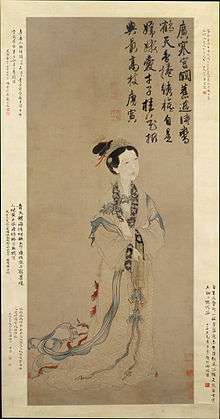Chang'e
| Chang'e | |||||||||||||||||||||||
 The painting The Moon Goddess Chang E, dated to the Ming dynasty | |||||||||||||||||||||||
| Chinese | 嫦娥 | ||||||||||||||||||||||
|---|---|---|---|---|---|---|---|---|---|---|---|---|---|---|---|---|---|---|---|---|---|---|---|
| |||||||||||||||||||||||
| Heng'e | |||||||||||||||||||||||
| Chinese | 姮娥 | ||||||||||||||||||||||
| |||||||||||||||||||||||
Chang'e or Chang-o, originally known as Heng'e,[lower-alpha 1] is the Chinese goddess of the Moon. She is the subject of several legends in Chinese mythology, most of which incorporate several of the following elements: Houyi the archer, a benevolent or malevolent emperor, an elixir of life and the Moon. She is married to the archer Houyi. In modern times, Chang'e has been the namesake of the Chinese Lunar Exploration Program.
Tales
There are many tales about Chang'e, including a well-known story which is given as the origin of the Mid-Autumn Moon Festival.[1] In a very distant past, ten suns had risen together into the skies and scorched the earth, thus causing hardship for the people.[1] The archer Yi shot down nine of them, leaving just one sun, and was given the elixir of immortality as a reward.[1] He did not consume it straight away, but hid it at home, as he did not want to gain immortality without his beloved wife Chang'e.[1] However, while Yi went out hunting, his apprentice Fengmeng broke into his house and tried to force Chang'e to give him the elixir; she refused and drank it herself.[1] Chang'e then flew upwards towards the heavens, choosing the moon as residence.[1] Yi discovered what had transpired and felt sad, so he displayed the Fruits and Cakes that Chang'e had liked, and gave sacrifices to her.[1]
Chang'e appears in Wu Cheng'en's novel Journey to the West.
Worship
The recently rediscovered divination text Guizang contains the story of Chang'e as a story providing the meaning to Hexagram 54 of the I Ching, "Returning Maiden".[2]
On Mid-Autumn Day, the full Moon night of the eighth lunar month, an open-air altar is set up facing the Moon for the worship of Chang'e. New pastries are put on the altar for her to bless. She is said to endow her worshippers with beauty.
Space travel
Chang'e was mentioned in a conversation between Houston CAPCOM and the Apollo 11 crew just before the first Moon landing in 1969:
- Ronald Evans (CC): Among the large headlines concerning Apollo this morning, is one asking that you watch for a lovely girl with a big rabbit. An ancient legend says a beautiful Chinese girl called Chang-O has been living there for 4,000 years. It seems she was banished to the Moon because she stole the pill of immortality from her husband. You might also look for her companion, a large Chinese rabbit, who is easy to spot since he is always standing on his hind feet in the shade of a cinnamon tree. The name of the rabbit is not reported.
- Michael Collins (CMP): Okay. We'll keep a close eye out for the bunny girl.[lower-alpha 2]
In 2007, China launched its first lunar probe, a robotic spacecraft named Chang'e 1 in the goddess' honour. A second unmanned probe, named Chang'e 2, was launched in 2010.[3] A third Chang'e spacecraft, a robotic lunar rover dubbed Chang'e 3, landed on the moon on Saturday, Dec. 14, 2013 at about 9:12 p.m., Beijing time, making China only the third country in the world to achieve such a moon feat after the former Soviet Union and the United States. The lander also delivered the robotic rover Yutu ("Jade Rabbit") to the lunar surface to begin its months-long driving mission. It has performed the first lunar soft landing since the Russian Luna 24 mission in 1976.
Notes
- ↑ The name Heng'e was changed to Chang'e due to a taboo character from a name of Emperor Wen of Han.
- ↑ NASA transcripts had attributed the response to Aldrin (Apollo 11 Technical Air-to-Ground Voice Transcription. National Aeronautics and Space Administration. Page 179), but corrected NASA transcripts attribute it to Collins (Woods, W. David; MacTaggart, Kenneth D.; O'Brien, Frank. "Day 5: Preparations for Landing". The Apollo 11 Flight Journal. National Aeronautics and Space Administration. Retrieved 26 June 2018.)
References
- 1 2 3 4 5 6 7 Yang & An 2005, 89-90 & 233.
- ↑ Shaughnessy, Edward L. (2014). Unearthing the Changes: Recently Discovered Manuscripts of the Yi Jing ( I Ching) and Related Texts. New York: Columbia University Press. p. 154. ISBN 0231533306.
- ↑ Clark, Stephen (1 October 2010). "China's second moon probe dispatched from Earth". Spaceflight Now. Retrieved 1 October 2010.
Bibliography
- Yang, Lihui; An, Deming (2005). Handbook of Chinese mythology. Santa Barbara: ABC-Clio. ISBN 1-57607-806-X.
Further reading
- Allan, Tony, Charles Phillips, and John Chinnery, Land of the Dragon: Chinese Myth, Duncan Baird Publishers, London, 2005 (through Barnes & Noble Books), ISBN 0-7607-7486-2
- Laing, Ellen Johnston, "From Thief to Deity: The Pictorial Record of the Chinese Moon Goddess, Chang E" in Kuhn, Dieter & Stahl, Helga, The Presence of Antiquity: Form and Function of References to Antiquity in the Cultural Centers of Europe and East Asia. Wuerzburg, 2001, pp. 437-54. ISBN 3927943223